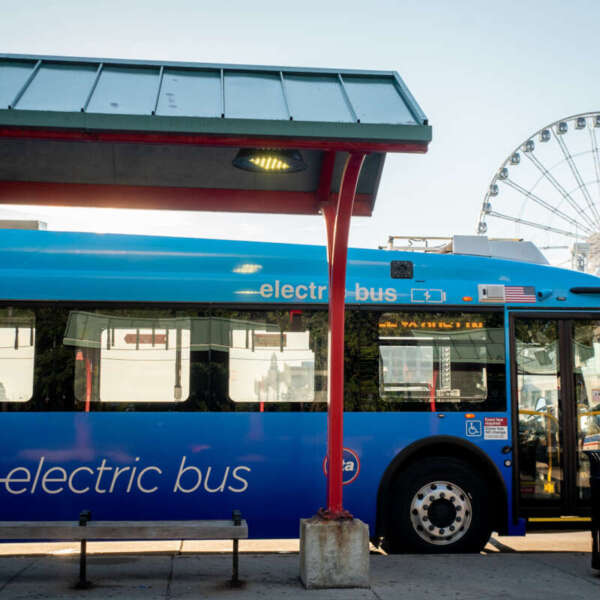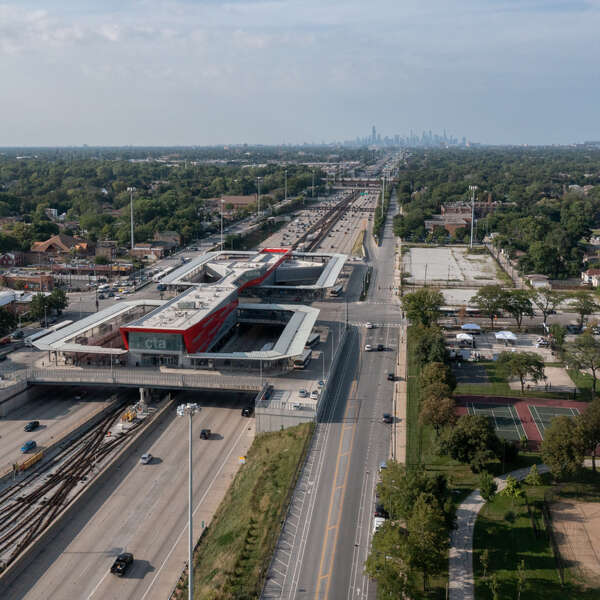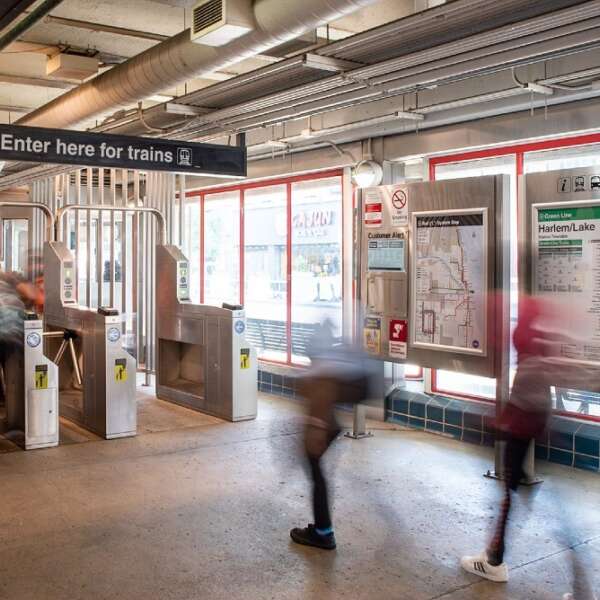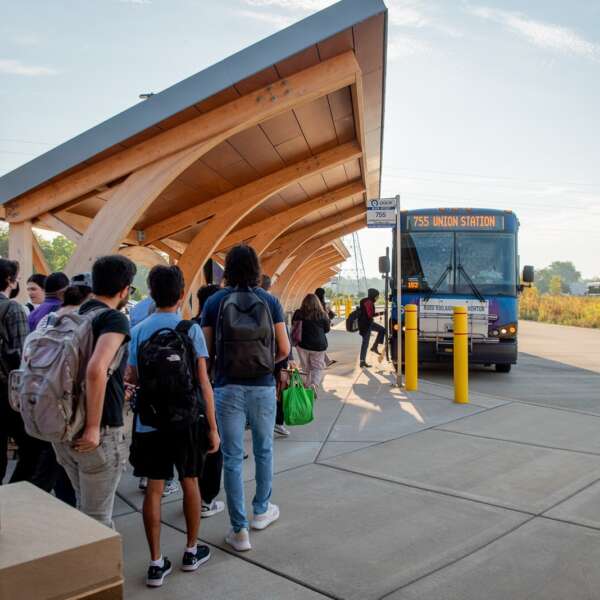Understanding capital vs. operating funding and why it matters
February 2, 2023
February 2, 2023

Funding the second largest transit system in the country is a large and complicated task. It’s true, Chicagoland’s transit system is facing a $730 million annual budget gap beginning in 2026 due to a looming operating funding crisis. It’s also true that major transit projects to improve the system are on the horizon—like the $3.6 billion CTA Red Line Extension, Metra’s nearly $1 billion new rail car purchase, or Pace’s multimillion dollar investment in electrification. It’s reasonable to ask how these two things can be true at the same time, and the answer lies in understanding the difference between capital and operating funding, where the money comes from, and how it can be spent.
Transit agencies receive funding from a variety of local, state, and federal sources that are required by the funder to be used for capital projects (like the Red Line Extension and rail car and bus purchases), and agencies receive funding through different mechanisms for operations (like fuel and labor costs). Agencies do not have the ability to transfer money from their capital programs to their operating budgets.
The regional transit operating budget refers to the expected revenues and expenses related to running the region’s transit system, including the salaries of the thousands of operators and support staff, fuel, and other daily expenses required to keep the buses and trains moving. In 2023, the regional transit operating budget is $3.6 billion.
Until COVID-19 hit, the federal government had not provided operating funding for the Chicagoland transit system since the 1980s. In 2020, as transit ridership declined around the country, the federal government recognized the essential nature of transit and included relief funding in three major bills passed in 2020 and 2021 (the CARES Act, CRRSAA, and the American Rescue Plan Act). These relief dollars allowed the RTA to allocate a total of $3.5 billion to CTA, Metra, and Pace to help offset fare revenue losses from declining ridership due to the pandemic and keep the system running for those who needed it most.
Because of long-term changes in travel patterns, the RTA does not expect ridership to return to pre-pandemic levels in the foreseeable future. Inflation, rising labor costs, and other trends mean that the cost to operate the system continues to grow in spite of efficient stewardship of public dollars that has allowed the agencies to stretch COVID relief money through 2025. These trends combine to mean that starting in 2026, the RTA is projecting a $730 million annual regional operating budget shortfall. The RTA and its partners have developed a strategic plan, Transit is the Answer, for the future of transit, including a 10-Year Financial Plan that outlines possible options to help address the problem.
Before the COVID-19 pandemic, system generated revenue, largely comprised of fares, made up about half of the operating budget, as required by state law. As of October 2022, ridership is at about 50 percent of pre-pandemic levels, and fare revenue has taken a corresponding hit. This overreliance on fares is rare for transit systems and is unsustainable for the Chicago region moving forward.
The Service Boards also generate revenue from advertising, concessions, rentals, and other partnerships.
Illinois law authorizes the RTA to impose a sales tax throughout the six-county Northeastern Illinois region. The RTA sales tax is collected by the Illinois Department of Revenue and paid to the Treasurer of the State of Illinois to be held in trust for the RTA outside of the State treasury. Proceeds from the RTA sales tax are paid directly to the RTA monthly. The January 1, 2021, expansion of the RTA sales tax to more on-line sales and subsequent inflation have significantly increased RTA sales tax receipts over the last two years.
The sales tax rates imposed by the RTA differ by county in order to recognize the differing levels of transit service provided in the six-county region. In Cook County the RTA imposes a 1.25% sales tax whereas in DuPage, Kane, Lake, McHenry, and Will Counties the rate is 0.50%. The RTA sales tax is expected to generate more than $1.5 billion in 2023.
In 2008, the General Assembly granted the city of Chicago the authority to impose an additional Real Estate Transfer Tax (RETT) upon the privilege of transferring title to, or beneficial interest in, real property located in the City. The supplemental tax rate of $1.50 per $500 of the transfer price is imposed on all sales within the City for the purpose of providing financial assistance to the CTA. This supplemental tax rate is in addition to the tax rate of $3.75 per $500 of the transfer price that the City already imposed prior to 2008. The supplemental tax is referred to as the “CTA portion” of the RETT, and the $3.75 tax is referred to as the “City portion.” The CTA’s portion of the RETT is projected to be approximately $75 million in 2022.
Illinois law provides that the state transfers money from the State of Illinois’ General Revenue Fund to the Public Transportation Fund in an amount equal to 30% of the revenue realized from the RTA Sales Tax and 30% of the revenue realized from the CTA’s portion of the Real Estate Transfer Tax (RETT) in the City of Chicago. Consequently, the state money dedicated to public transportation increases or decreases at a rate equal to the growth or decline of both sales tax and the RETT. The RTA expects to receive nearly $500 million of PTF in 2023.
Illinois law requires that the State of Illinois reimburse the RTA for the cost of the RTA’s debt service payments for the RTA’s Strategic Capital Improvement Program (SCIP) bonds. Although this is related to the system’s capital projects, it appears in the operating budget to offset the annual debt service expense, which is also accounted for in the operating budget. The RTA expects to receive $130 million of this funding from the State in 2022.
Originally established by a Memorandum of Understanding in November of 2009, $8.4 million in funding for ADA Paratransit was appropriated for State fiscal year 2022.
The capital program funds are used to invest in the long-term maintenance, upkeep, and any improvements or expansion of the system. This includes things such as new vehicles, repairs to stations and tracks, upgraded technology, and infrastructure that improves accessibility like elevators and ramps. The 2023-2027 Capital Program totals $5.7 billion.
Recent major influxes in capital funding from state and federal infrastructure bills have led to many long-needed projects being started in the Chicago region, and many more are planned. However, the maintenance costs for the region’s transit system are great and a long-term sustainable funding solution is needed to keep transit in a state of good repair today, and for the next generation.
Learn more about how the capital dollars are spent according to priorities such as safety, equity, and accessibility, and view a map of current projects underway.
Capital funding comes from a variety of federal, state, and local sources. The federal government, through the Federal Transportation Administration (FTA), provides both formula and discretionary funds to the region. The state provides both bond funds (when new state capital programs are enacted) as well as gas tax revenue referred to as “PAYGO.” Local sources include bond issuances by both the RTA and CTA as well as funding pools made available through various local governmental sources. The region continually advocates for additional funding to meet the great need to both maintain and improve the system. Recent efforts have resulted in over $425 million a year in additional funding via the Infrastructure Investment and Jobs Act (IIJA) and gas tax revenue (PAYGO funding).
IIJA, signed into law on November 15, 2021, is a significant investment in the nation’s transit infrastructure. It provides nearly 40% more funding per year in federal formula funds, which amounts to over $200 million per year. The legislation also authorizes several new transit discretionary programs which the region is competing for.
The state’s enactment of the Rebuild Illinois program in June 2019 provided the RTA system with $2.6 billion in bond funding, which was programmed in 2020 and 2021. In addition, an estimated $227 million in gas tax revenue (PAYGO funding) is available on an annual basis.
While the increase in capital funding over the past four years has been critical in advancing improvements to the system, capital needs in our region are great. The region’s portfolio of transit infrastructure needs an annual investment of $3.5 billion over the next 10 years to address chronic disinvestment, to achieve a “state of good repair,” to make improvements to the sustainability of transit, and to improve accessibility, reliability, and equity. The region’s 2023 capital program identified 76 Priority Projects for the next 10 years with a total cost of $36.6 billion. The 2023-2027 5-year capital program only funds 15.6% of this total 10-year need, with only nine of the projects fully funded. Important projects to maintain and transform the regional transportation system are delayed as the Service Boards work to put funding strategies together to advance key projects.
Transit is the answer to many of the most urgent challenges facing us today, and investing in transit is key to advancing equity, growing our economy, and combating climate change. The reality is transit has been drastically underfunded in the United States and in our region on both the capital and the operating sides. While ridership has not recovered to pre-pandemic levels, our system provides nearly 1 million rides a day and has an economic impact of over $17 billion annually. For every $1 invested in the transit system, the region gains $3.86 in benefits. In truth, we cannot afford not to adequately fund our system.
Transit is the Answer identifies potential funding solutions and lays out an agenda for advocacy and action that addresses safety, reliability, speed, and other improvements to the transit system. It is our shared responsibility to build a sustainable model of investment in the operations, upkeep, and modernization of our regional public transportation assets. Join our coalition to take future action and advocate with us for these solutions.
Subscribe to our Newsletter
Related Articles
 New project management oversight report highlights more than 100 projects representing $8.2 billion in capital investments
New project management oversight report highlights more than 100 projects representing $8.2 billion in capital investments
The RTA’s Project Management Oversight (PMO) program ensures that the Service Boards—CTA, Metra, and Pace—are spending capital funds and managing their infra...
June 27, 2024 Transportation Tuesday recap: Improving and expanding the transit system strategically
Transportation Tuesday recap: Improving and expanding the transit system strategically
With last year’s adoption of Transit is the Answer came 15 new evaluation metrics that comprise a strategy for evaluating and selecting capital projects. Now...
May 30, 2024 Transit is the answer to meeting Illinois’ climate goals
Transit is the answer to meeting Illinois’ climate goals
As we celebrate Earth Day 2024, the RTA is announcing Transforming Transit —the agency’s commitment to lead the Chicago region’s transit system into the futu...
April 18, 2024 Three years into the Infrastructure Investment and Jobs Act, Chicago’s transit system is winning competitive grants and advancing critical projects
Three years into the Infrastructure Investment and Jobs Act, Chicago’s transit system is winning competitive grants and advancing critical projects
The Infrastructure Investment and Jobs Act (IIJA), passed in 2021, represented a historic level of federal investment for shoring up the nation’s infrastruct...
March 12, 2024 Why fully funding paratransit service and reduced fare programs is key to closing the transit budget gap
Why fully funding paratransit service and reduced fare programs is key to closing the transit budget gap
With transit facing a fiscal cliff in the coming years, fully funding critical programs like ADA paratransit service and free and reduced fare programs is on...
February 29, 2024 RTA releases semi-annual project management oversight report highlighting more than 100 capital projects
RTA releases semi-annual project management oversight report highlighting more than 100 capital projects
Under its Project Management Oversight (PMO) program, the RTA ensures that the Service Boards—CTA, Metra, and Pace—are spending capital funds and managing th...
January 3, 2024